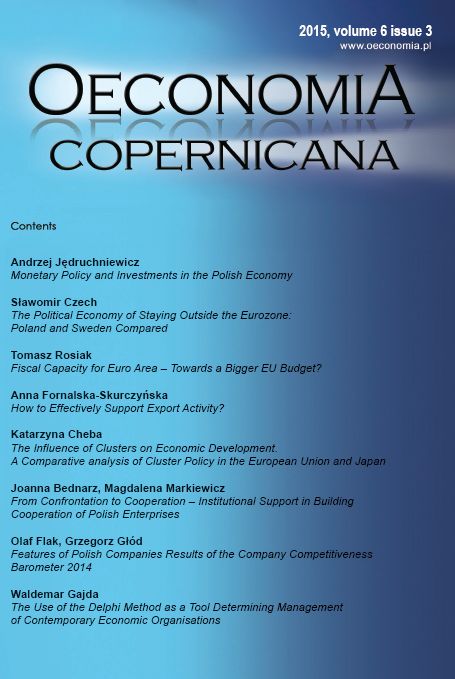From confrontation to cooperation ? institutional support in building cooperation of Polish enterprises
DOI:
https://doi.org/10.12775/OeC.2015.023Keywords:
cooperation, enterprise policy, institutional support, economic development, Polish enterprisesAbstract
The article presents results of critical theoretical and empirical analysis of cooperation between Polish enterprises based on two models: made by T. Ozawa and M.E. Porter, and followed by market research concerning opportunities to support cooperation of Polish enterprises. Polish companies seem to opt for confrontation as the main market strategy, basing on the development of one company while worsening the position of rivals at the same time. The aim of this paper is to show possibilities in supporting Polish companies to build their capabilities, as well as identifying barriers, in transition from confrontation to cooperation. The article is divided into four parts. In the first part, the stages of development of economy and enterprises in Europe are defined with reference to T. Ozawa model. The analysis covers the internationally recognised innovation indicators with regard to cooperation aspects. In the second part, the authors analyse the essence and forms of cooperation between companies. The third part of the paper concentrates on the market research of the support means available for Polish enterprises. In conclusion, a brief summary of the main findings was given, concerning the opportunities and barriers of institutional approach towards cooperation between Polish enterprises. In the paper, two types of research methods were used: methods of data collection and methods of organizing and processing information, especially methods of systems, cause and logical analysis of institutional support.
Downloads
References
Arundel, A. & Hollanders, H. (2015). EXIS: An Exploratory Approach to Innovation Scoreboards. Retrieved from http://arnop.unimaas.nl/show.cgi?fid=15501 (01.03.2015).
Arundel, A. & Hollanders, H. (2006). Global Innovation Scoreboard GIS Report. European Trend Chart on Innovation, European Commission.
BGK (2015). Bank Gospodarstwa Krajowego, Retrieved from www.bgk.pl.
Batorski, D. (2013). Kapitał społeczny i otwartość jako podstawa innowacyjności. In P. Zadura-Lichota (Ed.). Świt innowacyjnego społeczeństwa. Trendy na najbliższe lata. Warszawa: PARP.
BOSSG (2015). BOSSG Consulting Sp. z o.o. Przewodnik klastry i regionalne sieci współpracy. Retrieved from http://ipdevelopment.pl/foto/dokument y/unia/1_2_D/Klastry_i_regionalne_sieci_wspolpracy.pdf (10.03.2015).
Campbell, D. & Netzer, A. (Ed.). (2009). International Joint Ventures. The Netherlands: Kluwer Law International.
Chesbrough, H.W. (2003). Open Innovation: The new imperative for creating and profiting from technology. Boston: Harvard Business School Press.
Dzikowski P. & Tomaszewski M. (2014). The impact of firm size and its ownership on innovation cooperation in medium-high and high technology sectors in Poland. Management, 18(1).
European Commission (2015a). Regional Research Intensive Clusters and Science Parks. Retrieved from http://ec.europa.eu/research/regions/documents /publications/sc_park.pdf (06.02.2015).
European Commission (2015b). Science, Technology and Innovation in Europe. Retrieved from http://ec.europa.eu/eurostat/documents/3930297/5969406/KS-GN-13-001-EN.PDF (07.02.2015).
Frąckowiak, W. & Lewandowski, M. (2009). Istota i motywy fuzji i przejęć przedsiębiorstw. In W. Frąckowiak (Ed.). Fuzje i przejęcia. Warszawa: PWE.
Hooke, J. C. (1996). A practical guide to doing the deal. New York: Wiley.
IUS (2014). Innovation Union Scoreboard 2014. Retrieved from http://ec.europa.eu/enterprise/policies/innovation/files/ius/ius-2014_en.pdf (20.02.2015).
Invest in Pomerania (2015). Invest in Pomerania. Retrieved from http://www.investinpomerania.pl/article/166920_Invest_in_Pomerania_najlepszym_Centrum_Obslugi_Inwestora_w_Polsce.htm (14.02.2015).
Jankowska, B. (2009). Konkurencyjność w ujęciu mezoekonomicznym. In M. Gorynia, E. Łaźniewska (Ed.). Kompendium wiedzy o konkurencyjności. Warszawa: Wydawnictwo Naukowe PWN.
Koszewski, R. (2011). Konsorcja eksportowe jako instrument aktywizacji eksportu dla małych i średnich przedsiębiorstw. Gdańsk: Wydawnictwo Uniwersytetu Gdańskiego.
Kozyra B. (2006). Alianse strategiczne jako źródło innowacji. Ekonomika i Organizacja Przedsiębiorstwa. 3.
Łobejko, S. (2013). Międzynarodowe rankingi, wskaźniki i serwisy innowacji. Dyskusja na temat użyteczności i potrzeb na rzecz polityki innowacyjnej w Polsce. In P. Zadura-Lichota (Ed.), Świt innowacyjnego społeczeństwa. Trendy na najbliższe lata, Warszawa: PARP.
Majewska, M. & Buszkowska, E. (2014). The Changes in the Position of Poland on Its Investment Development Path: The Results of the Empirical Analysis. Optimum. Studia Ekonomiczne, 5(71).
Markiewicz, M. & Bednarz, J. (2013). Znaczenie metody case study w kreowaniu postaw przedsiębiorczych studentów i absolwentów szkół wyższych. In W. Bizon & A. Poszewiecki (Eds.). Efektywność innowacyjnych narzędzi dydaktycznych w procesach kształtowania postaw przedsiębiorczych. Gdańsk: Wydawnictwo Uniwersytetu Gdańskiego.
Megginson, W.L., Smart, S. & Lucey B. (2008). Introduction to Corporate Finance. London: Thomson Learning.
Milbergs, E. & Vonortas, N. (2015). Innovation Metric: Measurement to Insights, White Paper prepared for National Innovation Initiative, 21st Century Innovation Working Group, IBM Corporation. Retrieved from http://www.ignyte.ms/ whitepapers/innovation-metrics-nii.pdf (07.03.2015).
Miyamoto, M., Lu, X. & Shimazaki Y. (2011). Patterns and Determinants of China?s Outward Foreign Direct Investment in 2008. Journal of Accounting and Finance, 11(3).
NESTA (2015). National Endowment for Science, Technology and the Arts. The Innovation Gap: Why policy needs to reflect the reality of innovation in the UK. Retrieved from http://www.nesta.org.uk/sites/default/files/innovation _gap.pdf (26.02.2015).
Ozawa, T. (1979). International Investment and Industrial Structure: New Theoretical Implications from the Japanese Experience. Oxford Economic Papers, 3(1).
PAIiIZ (2015). Polska Agencja Informacji i Inwestycji Zagranicznych & Hays Poland. 10 lat sektora nowoczesnych usług biznesowych w Polsce. Retrieved from www.paiiiz.pl (14.03.2015).
Phongpaichit, P. (1990). The New Wave of Japanese Investment in ASEAN: Determinants and Prospects. Singapore: ASEAN Economic Research Unit, Institute of Southeast Asian Studies.
PARP (2015). Polish Agency for Enterprise Development. Retrieved from www.parp.gov.pl.
Porter, M.E. (1990). The Competitive Advantage of Nations. New York: Free Press.
Porter, M.E. (1998). On competition. Boston: Harvard Business School.
Porter, M.E. (2000). Location, Competition, and Economic Development: Local Clusters in a Global Economy. Economic Development Quarterly, 14(1).
Puchalska, K. (2010). Bezpośrednie inwestycje zagraniczne w kontekście innowacyjności i modernizacji regionu. Nierówności społeczne a wzrost gospodarczy. 16.
RIGP (2015). Regionalna Izba Gospodarcza Pomorza. Retrieved from http://www.rigp.pl.
Sachwald, F. (2013). Japanese Firms in Europe: A Global Perspective. New York: Routledge.
UNIDO. (2003). Development of Clusters and Networks of SMEs: the UNIDO Programme. A Guide To Export Consortia, Vienna.
Yan, A. & Luo Y. (2001). International Joint Ventures. Theory and Practice. New York: M.E. Sharpe Inc.






